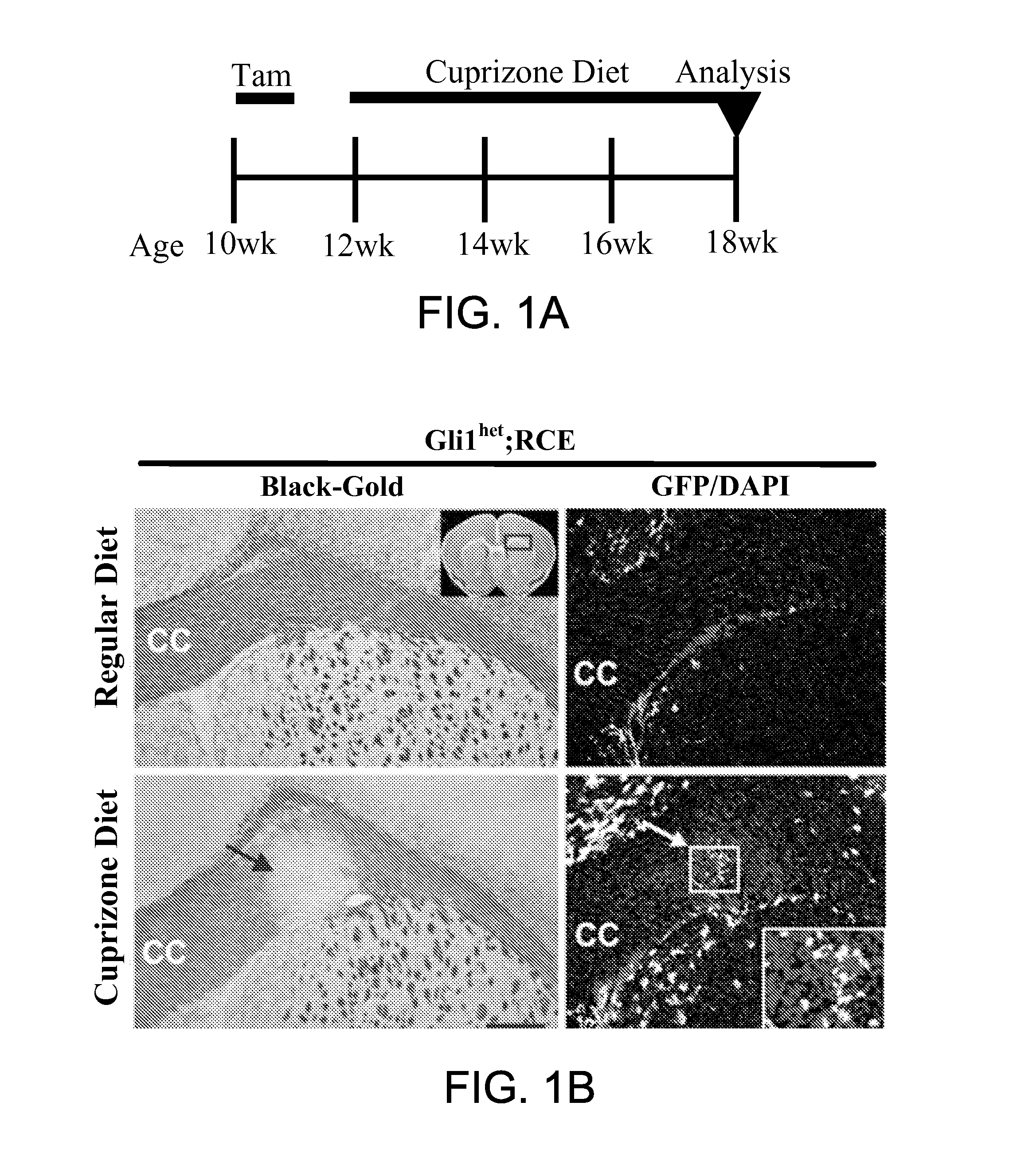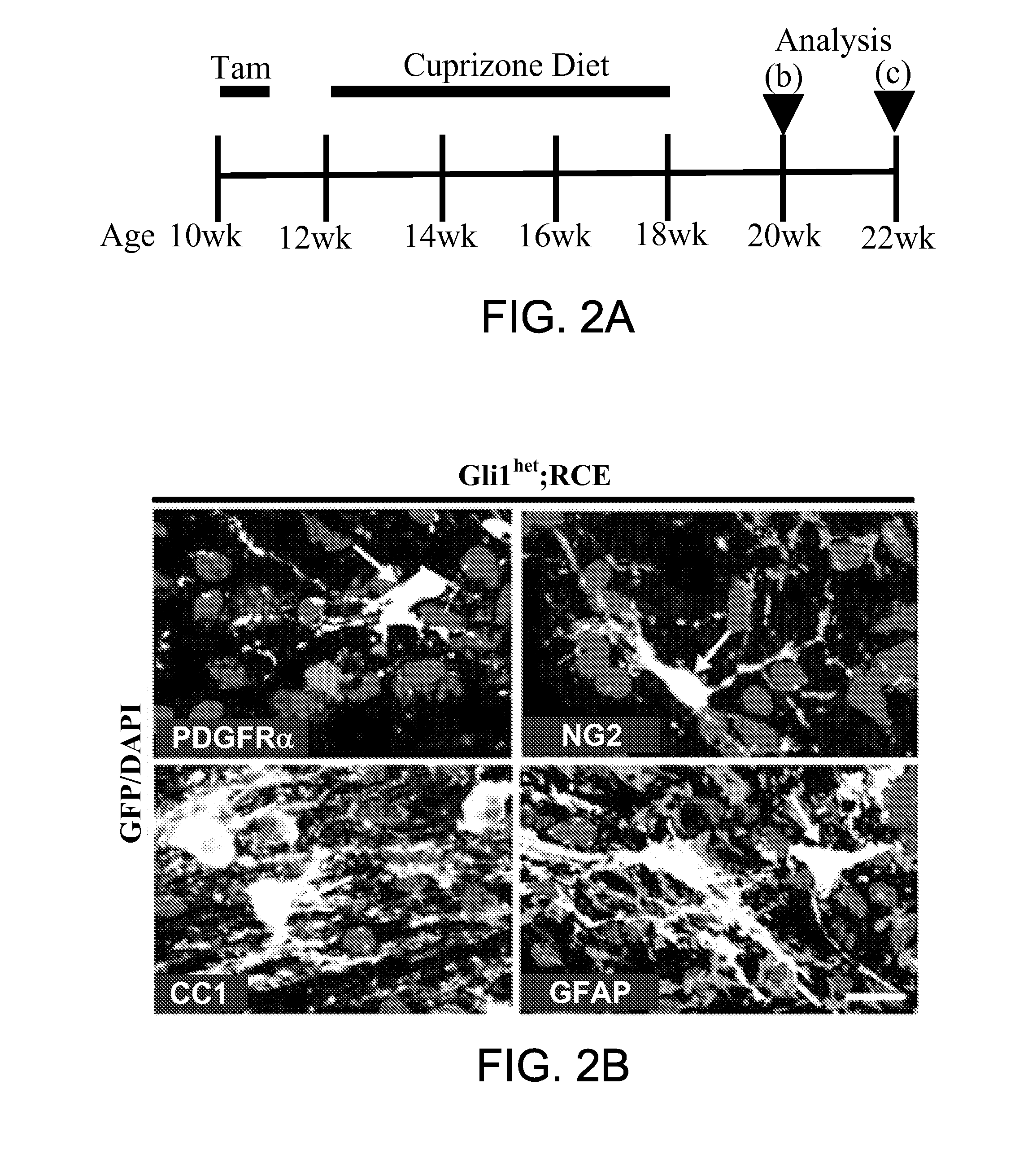Method for enhancing remyelination using gli1 inhibitors
- Summary
- Abstract
- Description
- Claims
- Application Information
AI Technical Summary
Benefits of technology
Problems solved by technology
Method used
Image
Examples
example 1
SHH Signaling Pathway is a Useful Therapeutic Target for Remyelination
[0078]The failure of oligodendrocytes (OL) to remyelinate effectively in multiple sclerosis (MS) leads to progressive deterioration of neurological function due to conduction block and neuronal degeneration. A key therapeutic goal is to identify the mechanisms that limit remyelination in order to develop new strategies to enhance remyelination and repair in MS. Recent evidence suggests that progenitor cells in the subventricular zone (SVZ) give rise to OLs (Menn et al., 2006; Picard-Riera et al., 2002).
[0079]Sonic Hedgehog (Shh) is a secreted morphogen required for the generation of OLs during development and for maintenance of stem cells in the adult SVZ. Binding of Shh to its receptor relieves the transmembrane protein smoothened (smo) from inhibition and results in transcription of Gli proteins, which are downstream effectors of Shh signaling.
[0080]The contribution of Shh-responsive cells and of Shh signaling d...
example 2
Gli1 Inhibition Results in Enhanced Remyelination by Stem Cells
[0086]Since Gli1 expression is induced by the highest levels of Shh, the present inventors investigated the role of Gli1 in the recruitment and differentiation of these Shh-responsive cells during remyelination. To this end, Gli1CreER / nLacZ;RCE (Gli1null;RCE) mice were generated to genetically map the fate of cells lacking Gli1. Brains from healthy adult mice were first examined by staining with Black-Gold myelin stain; no defects in myelination were evident compared to Gli1het;RCE mice (FIG. 6a). These results are consistent with previous studies reporting normal CNS development in the Gli1null mice (Bai et al., Development, 129:4753-4761, 2002). Tamoxifen was then administered to the Gli1null;RCE mice and they were fed either a normal diet or a diet supplemented with cuprizone. Brains from these mice were examined 2 weeks after cessation of cuprizone. In the Gli1null;RCE mice on a normal diet, as in the Gli1het;RCE mic...
example 3
Studies of the Effect of Gli1 Inhibitors in Animal Models of MS
[0091]The ability of Gli1 inhibitors of the invention to treat MS will be further assessed in animal models of MS.
[0092]Experimental autoimmune encephalomyelitis (EAE) is the most commonly used model for MS. It is induced by immunization of mice and rats, primarily, with myelin antigens including myelin oligodendrocyte glycoprotein (MOG), myelin basic protein (MBP), and proteolipid protein (PLP) (Hemmer et al., Nature Reviews Neuroscience, vol. 3, no. 4, pp. 291-301, 2002). The immunization is either active (administration of the specific antigens) or passive (administration of myelin-specific T cells). Several MS features are recapitulated by EAE, including paralysis, weight loss, demyelination, and inflammation in the CNS. In the EAE model, activated myelin-specific T cells, mainly Th1 and Th17 cells, contribute to the compromise of the BBB and migrate into the CNS. In the CNS, infiltrating and local antigen presenting...
PUM
 Login to View More
Login to View More Abstract
Description
Claims
Application Information
 Login to View More
Login to View More - R&D
- Intellectual Property
- Life Sciences
- Materials
- Tech Scout
- Unparalleled Data Quality
- Higher Quality Content
- 60% Fewer Hallucinations
Browse by: Latest US Patents, China's latest patents, Technical Efficacy Thesaurus, Application Domain, Technology Topic, Popular Technical Reports.
© 2025 PatSnap. All rights reserved.Legal|Privacy policy|Modern Slavery Act Transparency Statement|Sitemap|About US| Contact US: help@patsnap.com



